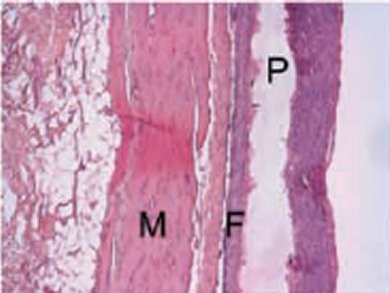Biodegradable elastomeric materials are of interest in the field of tissue engineering as their properties under force closely resemble the elastic nature of many human tissues. Different applications require elastomers with specifically tuned mechanical, biological, and degradation profiles to match the target tissue requirements.
Daniel Anderson and co-workers, Massachusetts Institute of Technology (MIT), USA, have developed a family of biodegradable poly(ester amide) elastomers. Poly(glycerol-sebacate) (PGS) and poly(xylitol-sebacate) (PXS) derivatives were prepared with different alkyl chain lengths and different molar ratios of sebacic acid/glycerol or sebacic acid/xylitol. Inclusion of a diamine motif improved the mechanical strength of the elasomers and helped them maintain their elasticity in aqueous environments.
The elastomers showed excellent in vitro and in vivo biocompatibility and slow in vivo degradation rates.
Image: Stained sections of subcutaneously implanted materials with surrounding tissues.
M – skin muscles, F – fibrous inflammatory zone, P – polymers (c) Wiley-VCH
- A Novel Family of Biodegradable Poly(ester amide) Elastomers
H. Cheng , P. S. Hill , D. J. Siegwart , N. Vacanti , A. K. R. Lytton-Jean, S.-W. Cho, A. Ye, R. Langer, D. G. Anderson,
Adv. Mater. 2011.
DOI: 10.1002/adma.201003482




